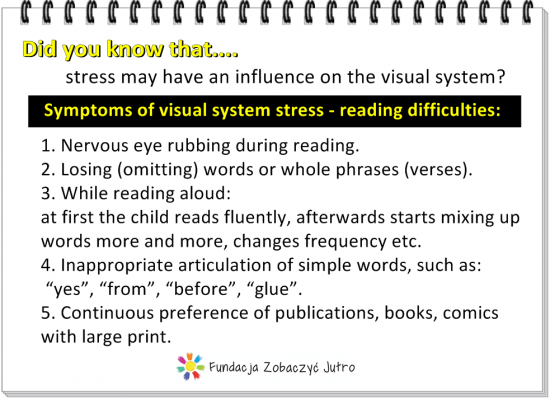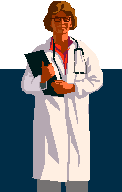We would like to highlight some of the eyesight problems that usually go undetected at an initial consultation with an ophthalmologist. Educators and school psychiatrists often cry, “the child is dyslectic!”. Problem outline: your child has difficulties in performing basic homework or even more creative activities, and you have no idea what is wrong.
STEP 1. YOU’RE ANXIOUS – YOU’RE LOOKING FOR SPECIALIST HELP. Example situation: First, you take your child to a physician, educator or school paediatrician. Examples of typical diagnosis/advice:
No 1. Suspicion of dyslexia. Advice: Regular exercises with the child should be initiated, preferably under the close supervision of a specialist.
No 2. It is likely that your child is maturing faster than his/her peers: “Do not be worried – everything will return to normal when the storm of hormones passes and your child feels better, does his/her homework, and is more willing to play”. An appointment at a children’s endocrinologist is advised.
No 3. An appointment at a neurologist or psychiatrist is advised. An inability to focus may be connected with hyperirritability or nervousness. The root of the problem lies with certain irregularities in the functioning of the nervous system.
• ADHD – Attention Deficit Hyperactivity Disorder, or
• ADD – Attention Deficit Disorder
No 4. If there are only a small number of symptoms, so-called “SIGHT SYSTEM STRESS” is suggested as a possible cause. Symptoms of this are typical in children who are at risk of long-term stress. Such behaviour may be caused by the atmosphere at home or family issues. The child spends too much time studying; they don’t perform enough relaxation exercises; they rarely play outside with peers (for example: blind man’s buff, hopscotch); they rarely participate in various entertainment activities (for example: at a playground, festivities). Hence difficulties in learning, focusing on mandated tasks, unwillingness to do homework etc.

No 5. Suggestion: “Make an appointment with an ophthalmologist. It is possible that there is a necessity to replace the lenses in your child’s glasses, as his/her vision has deteriorated” (In other words: clarity of vision has worsened).
RESULT | INITIAL DIAGNOSIS: After appointments with specialists – a neurologist, psychiatrist, child endocrinologist – and basic medical tests, the following are excluded: ADHD, ADD, hormone issues, optic system stress. So what then – dyslexia or deterioration of eyesight? You realise that your child has other problems, not just with reading, and you decide to also test his/her eyesight.
STEP 2. OPHTHALMOLOGIST APPOINTMENT IN ORDER TO TEST EYESIGHT. Eye checks might not include so-called refraction defects, i.e. for short-sightedness, long-sightedness or astigmatism. A careful selection of the correct lenses, bifocal sometimes, can eliminate reading problems entirely – only if we are not dealing with so-called impaired vision (LAZY EYE) and when there are not too many alarming symptoms. Proper lenses do not make your child see properly if he/she has a lazy eye (it can be the left or right eye), as sight deterioration results from incorrect functioning of the eyeball muscles. RESULT | DIAGNOSIS:
1. Deterioration of eyesight. Lenses have been replaced with new ones.
2. Eyesight has not deteriorated. Everything is fine. Lenses have not been replaced with new ones.
Difficulties in reading and writing do not go away. They may be caused by various eye disorders.For a complete picture of eyesight functions it is also necessary to assess other aspects of sight: convergence, collocation and eyeball movement, accommodation, spatial perception, three-dimensional perception.Symptoms of eyesight problems (such as short-sightedness) appear long before they are noticed, but further aspects regarding the functioning of the eye are “at first blush” practically unnoticeable!
During orthoptic examinations we often discover so-called latent squints, which make reading difficult and drive down the efficiency of reading in a significant way. Unfortunately, parents and teachers start noticing eyesight problems only when the child has problems with learning.
What’s next? In both cases, first – a check up at a certified orthoptist or orthometrist (or a strobolog ophthalmologis t) in order to exclude the risk of so-called vision dyslexia or to confirm that the child is suffering from this kind of dyslexia. Improvement in eyesight may be temporary so the problem will return, or the lenses make it even worse.
It is possible to eliminate or correct functional AMBLYOPIA without surgery (in order to do this we work out an individual program of orthoptic rehabilitation) due to the fact that damage to the structure of the eyeball has not occurred:

Do you know that amblyopia is the reduction of visual activity in one or both eyes?
Even perfectly fitting lenses are no substitute for orthoptic rehabilitation, which aims at, among other things, eliminating functional amblyopia (resulting from irregularities in the functioning, for instance, of the eyeball muscles).

Step 3.Are there different kinds of dyslexia? WHY IS AN APPOINTMENT WITH A CERTIFIED ORTHOPTIST NECESSARY?
Parents shouldn’t be satisfied with only an initial diagnosis as there are several varieties of dyslexia with various causes.
Dyslexia = specific difficulties with learning to read and write; It is divided into three types – optic dyslexia, hearing dyslexia and mixed dyslexia (optic–hearing).
Optic perception depends mainly on correct vision clarity and eyeball movement, for which eyeball muscles are responsible. Any disruption in the reception of the visual observations by a receptor (i.e. the eye) can be the cause of difficulties in reading and because of that may be equated with dyslectic problems.
All children in the dyslexia risk group should undergo professional orthoptic testing – the sooner the better for the benefit of the child’s development. Our standard orthoptic examination includes:
- an accommodation and convergence test
- distance acuity testing
- examining eyeball movement
- determining the convergence proximity point
- examining manifest and latent strabismus
- colour differentiation testing
- binocular vision testing; and
- corneal reflex test
STEP 4. AFTER A CHECK UP AT THE ORTHOPTIST: My child has been diagnosed with OPTIC DYSLEXIA. What does this mean in practice?
OPTIC-DYSLEXIA is a type of a growing dyslexia and often occurs in a mixed form known as optic-spatial dyslexia. In such a case it is necessary to work out a therapy and orthoptic rehabilitation plan in order to reverse irregularities with vision (more:).

Proper diagnosis (orthoptic testing – at an angle to difficulties in reading) and rehabilitation with professional equipment protect your child against significant learning difficulties. In cases of optic dyslexia, re-education classes and orthoptic exercises are very effective and eliminate existing irregularities entirely. We encourage you take a look at our videos on YouTube: “Questions and answers in the field of orthoptics”.

In the case of spatial-optic dyslexia (the most difficult to cure with therapy) the main cause constitutes optic perception disorders, most of the time connected with a delay in the child’s motor development and on a motor skill and sight coordination level.
Dear reader, in the next post we take a deep dive into optic dyslexia!
WE INVITE YOU FOR A DIAGNOSIS AND ORTHOPTIC REHABILITATION at our Office in Warsaw!
Reservations at tel.: 22 266 09 95 or via e-mail: biuro@zobaczycjutro.org. Our irreplaceable Certified Orthoptists are waiting to help you:


New help desk at our Children’s Eye Center



Najnowsze komentarze